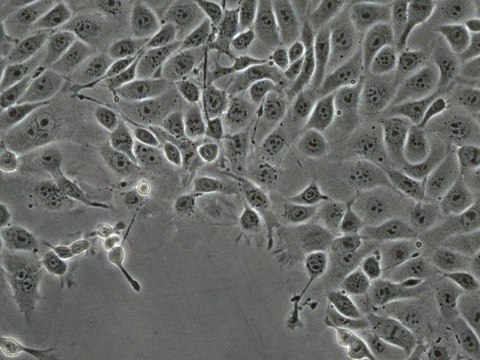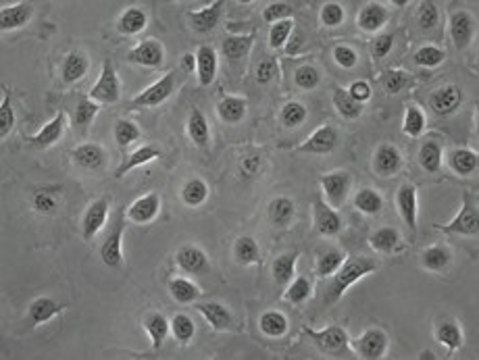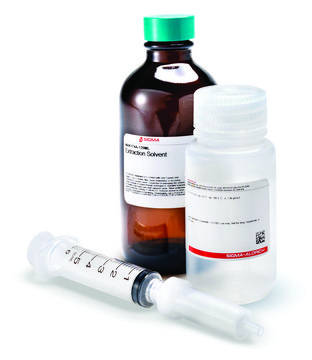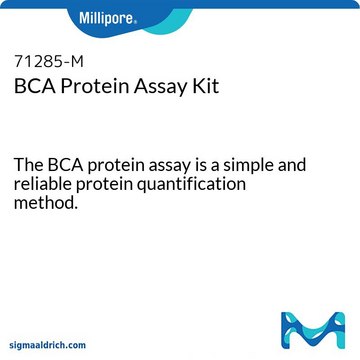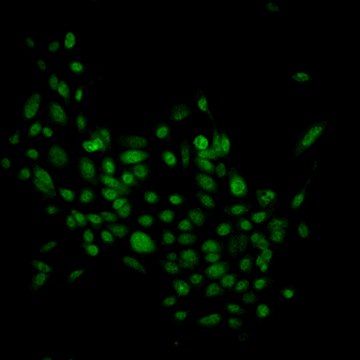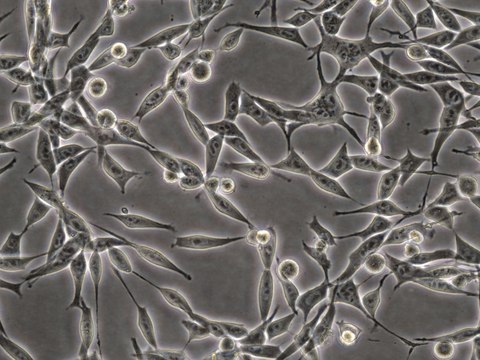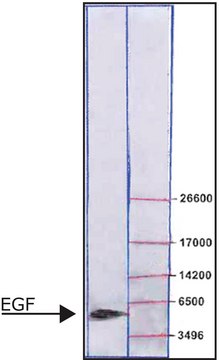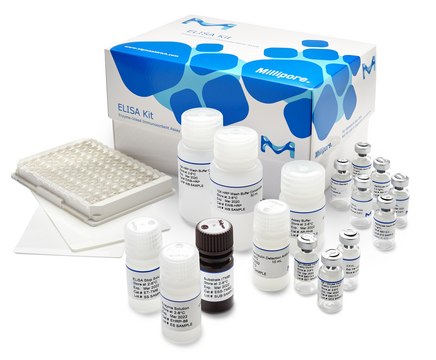SCC471
MOC22 Mouse Oral Squamous Cell Carcinoma (OSCC) Cell Line
Mouse
Synonym(s):
MOC2 cell line, mouse oral carcinoma 2 cell line, oral carcinoma cell line
Sign Into View Organizational & Contract Pricing
All Photos(6)
About This Item
UNSPSC Code:
41106514
NACRES:
NA.28
Recommended Products
Product Name
MOC22 Mouse Oral Squamous Cell Carcinoma (OSCC) Cell Line,
biological source
mouse
Quality Level
packaging
vial of ≥1X10⁶ cells/vial vials
manufacturer/tradename
Millipore
technique(s)
cell culture | mammalian: suitable
shipped in
liquid nitrogen
storage temp.
−196°C
Application
- Each vial contains >1X106 viable cells.
- MOC22 cells are verified to be of mouse origin and negative for human, rat, Chinese hamster, Golden Syrian hamster, and non-human primate interspecies contamination, as assessed by a Contamination Clear panel by Charles River Animal Diagnostic Services
- Cells tested negative for infectious diseases against a Mouse Essential CLEAR panel by Charles River Animal Diagnostic Services.
- Cells tested negative for mycoplasma.
Features and Benefits
The MOC (Mouse Oral Cancer) cell lines provide a syngeneic HNSCC cancer model that can be transplanted into C57BL/6 mice. These lines are important models for immune cell infiltration studies. The MOC lines have been utilized to compare and identify potential clinical scenarios that are applicable to human Oral Squamous Cell Carcinoma. The MOC22 cell line was derived from primary tumors in a C57BL/6 WT mouse and shows indolent growth compared with the aggressive, metastatic MOC2 line.
Target description
Despite ongoing efforts to understand growth and signaling pathways in head and neck squamous cell carcinoma (HNSCC), patient outcomes have remained largely unchanged in recent decades. A significant barrier to understanding and studying immune responses in the context of cancer in recent years has been the lack of available syngeneic mouse models. Xenograft approaches have historically been popular models, but they unfortunately do not model important adapative immunity responses.The MOC cell lines have expanded our understanding of CXCL14 downregulation in metastatic lymph nodes. Previously, CXCL14 expression had been associated with T-cell associated mechanisms for tumor suppression. Tumor Infiltrating Lymphocyte (TIL) studies using MOC1 and MOC2 have found a cell-specific association in Oral Squamous Cell Carcinomas (OSCCs) involving CXCL14 downregulation resulting in TIL increase which leads to tumor suppression.The MOC group of cell lines contained common HNSCC mutations in addition to human-related OSCC driver pathways. All MOC lines share RAS pathway mutations and MOC22 was found to have HRAS mutations which is relevant in relation to human HRAS-mutant OSCC groups. Source: The MOC22 cell line was derived from carcinogen-induced oral tumors in immunocompetent C57BL/6 mice.References: 1. Judd, N. P., Allen, C. T., Winkler, A. E., & Uppaluri, R. (2012). Comparative analysis of tumor-infiltrating lymphocytes in a syngeneic mouse model of oral cancer. Otolaryngology--Head and Neck Surgery, 147(3), 493-500.2. Parikh, A., Shin, J., Faquin, W., Lin, D. T., Tirosh, I., Sunwoo, J. B., & Puram, S. V. (2020). Malignant cell-specific CXCL14 promotes tumor lymphocyte infiltration in oral cavity squamous cell carcinoma. Journal for ImmunoTherapy of Cancer, 8(2).3. Onken, M. D., Winkler, A. E., Kanchi, K. L., Chalivendra, V., Law, J. H., Rickert, C. G., ... & Uppaluri, R. (2014). A surprising cross-species conservation in the genomic landscape of mouse and human oral cancer identifies a transcriptional signature predicting metastatic disease. Clinical Cancer Research, 20(11), 2873-2884.
Storage and Stability
MOC22 cells should be stored in liquid nitrogen until use. The cells can be cultured for at least 10 passages after initial thawing without significantly affecting cell marker expression and functionality.
Disclaimer
Unless otherwise stated in our catalog or other company documentation accompanying the product(s), our products are intended for research use only and are not to be used for any other purpose, which includes but is not limited to, unauthorized commercial uses, in vitro diagnostic uses, ex vivo or in vivo therapeutic uses or any type of consumption or application to humans or animals.
Storage Class Code
10 - Combustible liquids
WGK
WGK 3
Flash Point(F)
Not applicable
Flash Point(C)
Not applicable
Certificates of Analysis (COA)
Search for Certificates of Analysis (COA) by entering the products Lot/Batch Number. Lot and Batch Numbers can be found on a product’s label following the words ‘Lot’ or ‘Batch’.
Already Own This Product?
Find documentation for the products that you have recently purchased in the Document Library.
Our team of scientists has experience in all areas of research including Life Science, Material Science, Chemical Synthesis, Chromatography, Analytical and many others.
Contact Technical Service